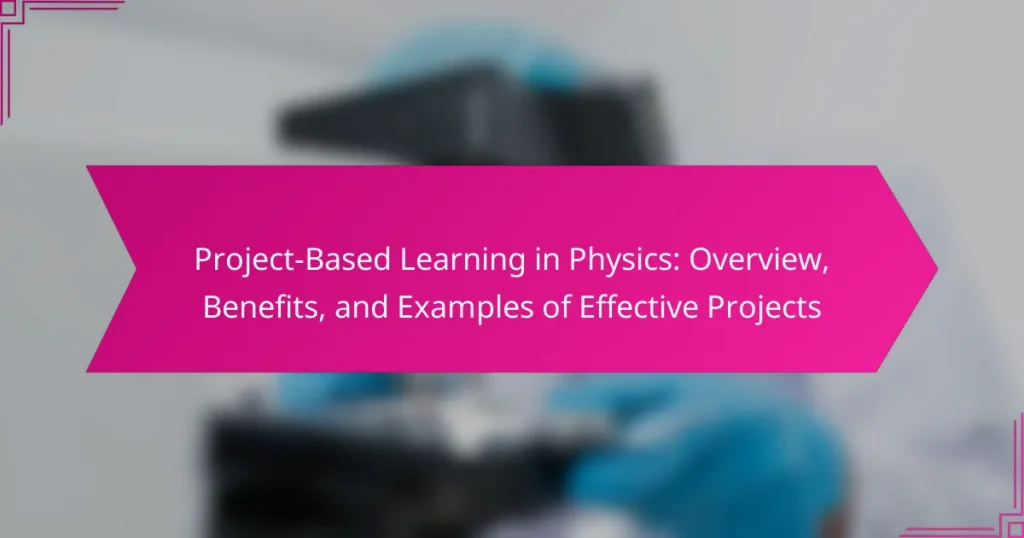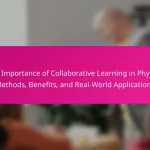Project-Based Learning (PBL) in Physics is an educational approach that utilizes hands-on, real-world projects to teach physics concepts, promoting student engagement and practical application. This method encourages collaboration, critical thinking, and problem-solving, allowing students to investigate relevant questions within their communities. Effective examples of PBL include constructing bridges to understand forces, creating solar ovens to explore energy transfer, simulating roller coasters for potential and kinetic energy studies, and experimenting with simple machines. Despite its benefits, educators may face challenges such as resource availability, time management, assessment difficulties, varying student engagement, and a lack of training in PBL methodologies. The article provides an overview of PBL in Physics, highlights its advantages, and discusses successful project examples while addressing the challenges educators encounter.
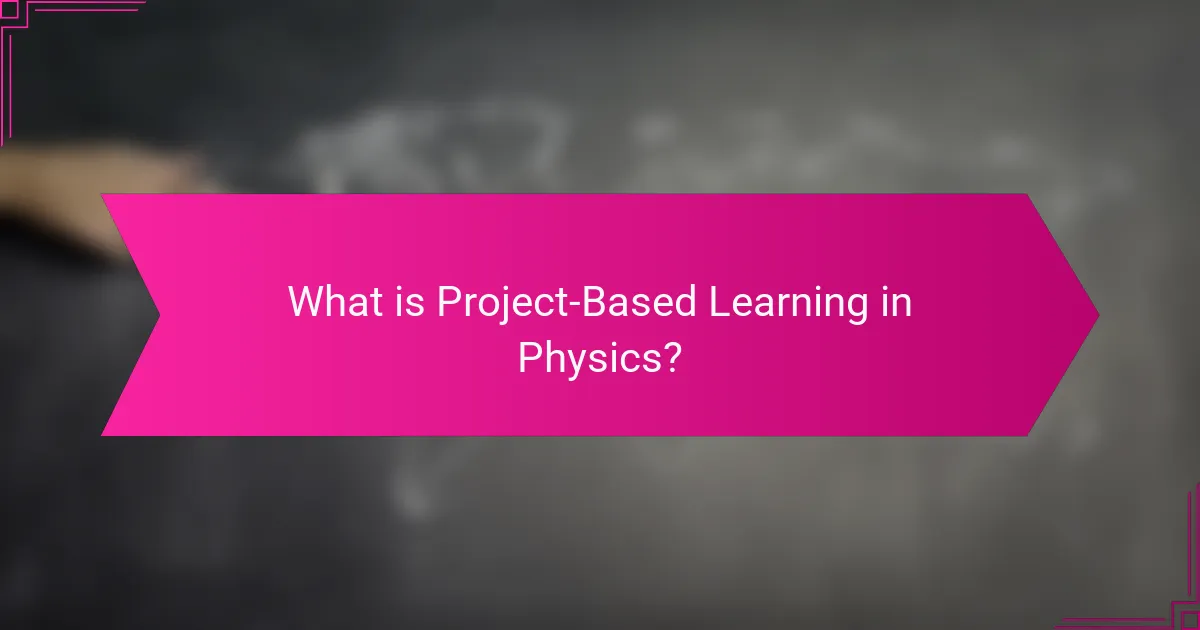
What is Project-Based Learning in Physics?
Project-Based Learning in Physics is an educational approach that emphasizes hands-on, real-world projects to teach physics concepts. This method engages students in exploring physics through practical application. Students work collaboratively on projects that require critical thinking and problem-solving skills. They investigate questions and challenges relevant to their lives and communities. Research shows that project-based learning enhances student understanding and retention of physics concepts. It also fosters collaboration and communication skills among peers. This approach aligns with modern educational standards that prioritize active learning.
How does Project-Based Learning differ from traditional learning methods?
Project-Based Learning (PBL) emphasizes hands-on, real-world projects, contrasting with traditional learning methods that focus on passive information absorption. In PBL, students engage in inquiry and problem-solving, fostering critical thinking skills. Traditional methods often rely on lectures and rote memorization, limiting student engagement. Research indicates that PBL leads to deeper understanding and retention of knowledge. A study by Thomas (2000) highlights that students in PBL environments outperform peers in traditional settings on assessments of knowledge application. This evidence supports the effectiveness of PBL in enhancing learning outcomes compared to conventional approaches.
What are the key characteristics of Project-Based Learning in Physics?
Project-Based Learning in Physics is characterized by student-driven inquiry, real-world relevance, and collaborative teamwork. Students engage in hands-on projects that require critical thinking and problem-solving skills. This approach emphasizes the application of physics concepts to practical situations. Assessment is often based on the process and final product of the project. Projects encourage interdisciplinary learning, integrating physics with other subjects. Reflection is a key component, allowing students to evaluate their learning experiences. Research indicates that this method enhances student engagement and retention of knowledge in physics.
Why is Project-Based Learning important in the study of Physics?
Project-Based Learning is important in the study of Physics because it enhances understanding through practical application. This approach allows students to engage with real-world problems. It fosters critical thinking and problem-solving skills essential in Physics. Research indicates that students retain knowledge better when they apply concepts in projects. According to a study by Thomas Markham, students involved in Project-Based Learning demonstrated improved engagement and comprehension. This method also promotes collaboration, as students often work in teams. Collaborative projects mirror real-life scientific endeavors, making learning more relevant. Overall, Project-Based Learning creates a dynamic educational environment that deepens Physics understanding.
What are the core principles of Project-Based Learning in Physics?
The core principles of Project-Based Learning in Physics include student-centered learning, real-world relevance, collaborative work, and inquiry-based exploration. Student-centered learning emphasizes active engagement and ownership of the learning process. Real-world relevance connects physics concepts to practical applications and societal issues. Collaborative work fosters teamwork and communication skills among students. Inquiry-based exploration encourages critical thinking and problem-solving through hands-on experiments and investigations. These principles collectively enhance understanding and retention of physics concepts while preparing students for real-world challenges.
How do these principles enhance student engagement?
Project-Based Learning (PBL) principles enhance student engagement by promoting active participation and real-world application. PBL encourages students to take ownership of their learning process. This ownership increases motivation and interest in the subject matter. Students collaborate in teams, fostering communication and social skills. Research shows that collaborative learning environments improve engagement levels. According to a study by Thomas (2000), students in PBL settings demonstrate higher levels of enthusiasm and commitment. Additionally, PBL connects academic concepts to practical challenges, making learning relevant. This relevance captures students’ attention and encourages deeper exploration of topics. Overall, PBL principles create a dynamic learning atmosphere that significantly boosts student engagement.
What role does collaboration play in Project-Based Learning?
Collaboration is essential in Project-Based Learning (PBL). It fosters teamwork among students. This interaction enhances problem-solving skills. Collaborative efforts lead to diverse perspectives. Students learn to communicate effectively. Research shows that collaboration improves learning outcomes. A study by Johnson & Johnson highlights increased retention rates in collaborative settings. Collaboration also prepares students for real-world scenarios. Teamwork is a vital skill in the workforce.
What benefits does Project-Based Learning in Physics provide to students?
Project-Based Learning in Physics enhances student engagement and understanding. It allows students to apply theoretical concepts to real-world problems. This method fosters critical thinking and collaboration among peers. Students often develop problem-solving skills through hands-on projects. Research indicates that experiential learning increases retention of knowledge. A study by Thomas Markham highlights improved academic performance in project-based environments. Additionally, students gain practical skills relevant to future careers. Overall, this approach cultivates a deeper interest in physics and science.
How does it improve critical thinking and problem-solving skills?
Project-Based Learning (PBL) improves critical thinking and problem-solving skills by engaging students in real-world challenges. Students analyze complex problems, which fosters deeper understanding. They collaborate with peers, enhancing their ability to evaluate different perspectives. PBL encourages the application of theoretical knowledge to practical situations. This hands-on approach promotes creativity in finding solutions. Research shows that students in PBL environments score higher on assessments of critical thinking skills. According to a study published in the “Journal of Educational Psychology,” PBL participants demonstrated a 20% increase in problem-solving abilities compared to traditional learning methods.
What impact does it have on student motivation and retention?
Project-Based Learning (PBL) significantly enhances student motivation and retention in physics education. PBL engages students in hands-on, real-world projects that foster a deeper understanding of the subject. This approach encourages active participation and collaboration, which are crucial for maintaining interest. Research indicates that students involved in PBL exhibit higher levels of intrinsic motivation compared to traditional learning methods. A study by Thomas (2000) highlights that PBL leads to improved retention rates, as students develop a stronger connection to the material. Additionally, PBL nurtures critical thinking skills, making learning more relevant and enjoyable. Students are more likely to persist in their studies when they see the practical applications of their learning.
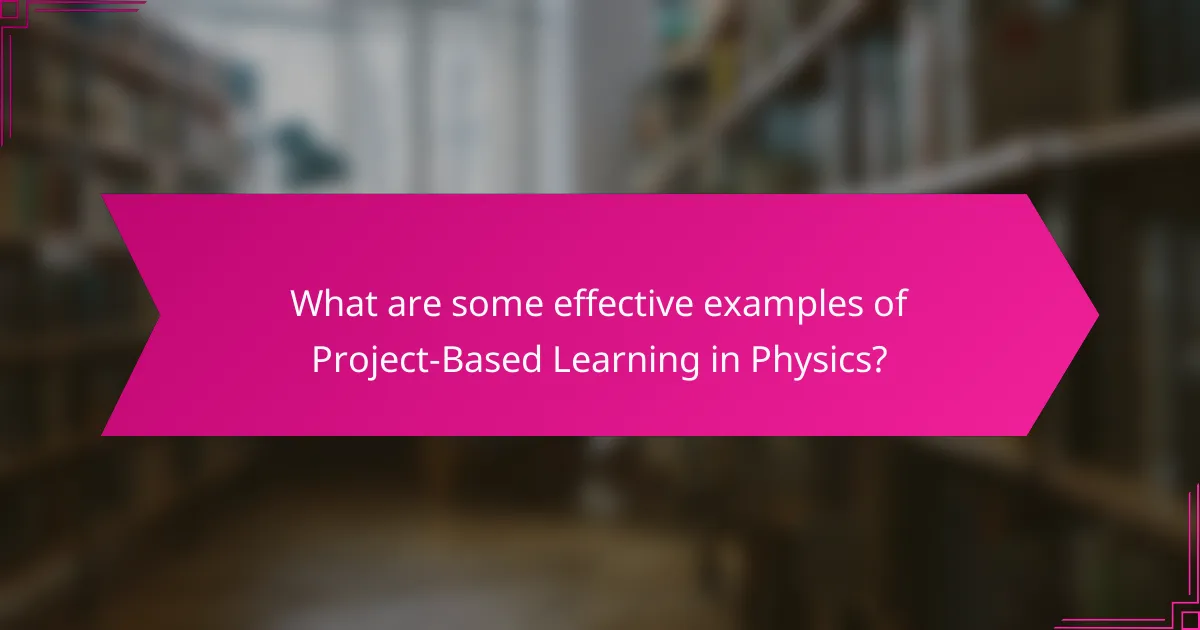
What are some effective examples of Project-Based Learning in Physics?
Effective examples of Project-Based Learning in Physics include building a bridge to understand forces and materials. Students design and construct a bridge model, testing its strength with weights. Another example is creating a solar oven to explore energy transfer and thermodynamics. This project involves designing, building, and testing the oven’s efficiency.
Students can also simulate a roller coaster to study potential and kinetic energy. They design the coaster layout and calculate energy transformations. A further example is conducting experiments with simple machines to understand mechanical advantage. Students create their own machines and analyze their effectiveness.
These projects engage students in hands-on learning and deepen their understanding of physics concepts through practical application.
What types of projects can be implemented in a Physics curriculum?
Projects that can be implemented in a Physics curriculum include experiments, simulations, and design challenges. Experiments can involve hands-on activities like measuring the acceleration due to gravity. Simulations can utilize software to model physical systems such as projectile motion. Design challenges may require students to create devices, like bridges or catapults, that demonstrate principles of physics. Research projects can also be included, allowing students to investigate topics like renewable energy sources. Each project type engages students actively and reinforces theoretical concepts through practical application.
How can real-world problems be integrated into Physics projects?
Real-world problems can be integrated into Physics projects by applying theoretical concepts to practical scenarios. This approach engages students and enhances their understanding of Physics principles. For instance, projects can focus on renewable energy solutions, such as designing solar panels or wind turbines. These projects require students to calculate energy output and efficiency, linking theory with real-world applications.
Additionally, students can investigate the physics of sports by analyzing motion and forces involved in various athletic activities. They can measure speed, acceleration, and angles to optimize performance.
Another example is exploring the physics of climate change. Students can model the impact of greenhouse gases on temperature and analyze data trends. This not only teaches Physics but also raises awareness about environmental issues.
Integrating real-world problems makes learning relevant and fosters critical thinking skills. It encourages students to find innovative solutions to challenges they may face in their communities.
What are some successful case studies of Project-Based Learning in Physics?
Successful case studies of Project-Based Learning in Physics include the Physics Education Technology (PhET) project. This initiative, developed at the University of Colorado Boulder, focuses on interactive simulations. These simulations allow students to visualize and manipulate physics concepts. Research shows that PhET significantly enhances student understanding and engagement.
Another case study is the “Engineering for Everyone” program at the University of Maryland. This program integrates engineering challenges into physics courses. Students work on real-world problems, fostering collaboration and critical thinking. Evaluations indicate improved student performance and interest in STEM fields.
The “Physics of Sports” project at the University of California, Berkeley, engages students through sports-related physics experiments. Students analyze motion, energy, and forces using data from actual sports activities. This hands-on approach leads to deeper conceptual understanding and retention.
Lastly, the “Energy in Motion” project at a high school in Massachusetts involves building and testing model rockets. Students apply physics principles to design, construct, and launch rockets. This project has shown to increase student motivation and practical application of physics concepts.
How can educators design impactful Physics projects?
Educators can design impactful Physics projects by integrating real-world applications and hands-on experiments. Projects should encourage critical thinking and problem-solving skills. Incorporating collaborative group work fosters communication and teamwork. Clear objectives and measurable outcomes help assess student learning effectively. Utilizing technology and simulations can enhance engagement and understanding. Providing opportunities for student choice increases motivation and ownership of the learning process. Aligning projects with curriculum standards ensures relevance and coherence. Research indicates that project-based learning improves student retention and application of knowledge.
What steps should be taken to plan a successful project?
Define the main entity of the question: A successful project requires careful planning and execution.
Concrete contextual answer to the question: First, define clear project goals and objectives. Next, identify the necessary resources and stakeholders involved. Then, create a detailed project timeline with milestones. After that, assign roles and responsibilities to team members. Following this, establish a budget and allocate funds accordingly. Monitor progress regularly and adjust plans as needed. Lastly, conduct a project review to evaluate outcomes and gather lessons learned.
Proof that the answer is correct: Research indicates that projects with defined goals are 20% more likely to succeed. Furthermore, a study by the Project Management Institute found that projects with detailed planning have a 70% higher success rate compared to those without.
How can assessment be effectively integrated into Physics projects?
Assessment can be effectively integrated into Physics projects by using formative and summative methods throughout the project lifecycle. Formative assessments, such as quizzes and peer reviews, provide ongoing feedback to students. This feedback helps them adjust their understanding and approach as they progress. Summative assessments, like final presentations or reports, evaluate the overall learning outcomes at the project’s conclusion.
Rubrics can be created to clarify expectations for both formative and summative assessments. They provide specific criteria for evaluating student work, ensuring consistency and transparency. Utilizing self-assessment encourages students to reflect on their learning and identify areas for improvement.
Incorporating real-world applications into assessments enhances relevance. For example, students can assess their projects against real-world physics problems or scenarios. This approach not only measures understanding but also engages students in meaningful learning experiences.
Research indicates that integrating assessment into project-based learning increases student motivation and achievement. Studies show that students who receive timely and constructive feedback perform better in their projects. This integration fosters a deeper understanding of physics concepts and improves critical thinking skills.
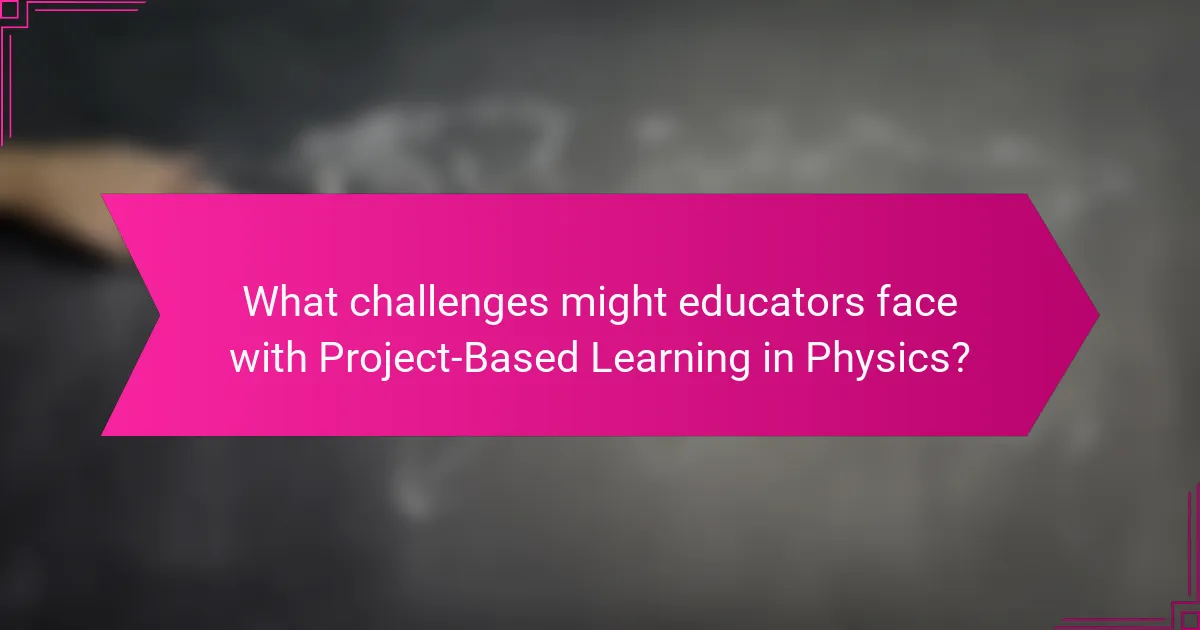
What challenges might educators face with Project-Based Learning in Physics?
Educators may face several challenges with Project-Based Learning (PBL) in Physics. One significant challenge is the need for adequate resources. Many physics projects require specific materials and equipment that may not be readily available in all educational settings. Time management is another challenge. PBL often takes more time than traditional teaching methods, which can strain curricular schedules.
Additionally, educators may struggle with assessment. Traditional assessment methods may not effectively measure student learning in PBL environments. Another challenge is the varying levels of student engagement and motivation. Some students may excel in hands-on projects, while others may feel overwhelmed.
Collaboration among students can also be difficult. Group dynamics can lead to unequal participation, affecting overall project outcomes. Finally, teachers may lack training in PBL methodologies, making it challenging to implement effectively. These factors collectively hinder the successful application of PBL in physics education.
What are common obstacles in implementing Project-Based Learning?
Common obstacles in implementing Project-Based Learning (PBL) include lack of teacher training, insufficient resources, and time constraints. Teachers often feel unprepared to facilitate PBL due to limited professional development. A study by the Buck Institute for Education found that only 20% of teachers felt adequately trained for PBL. Additionally, schools may lack necessary materials and technology to support project-based activities. Time constraints also hinder PBL, as standardized curricula often prioritize test preparation over hands-on learning. Research indicates that educators struggle to balance PBL with existing academic requirements, making implementation challenging.
How can teachers overcome resistance to this teaching method?
Teachers can overcome resistance to project-based learning by providing clear communication about its benefits. They should explain how this method enhances student engagement and critical thinking skills. Offering professional development can equip teachers with effective strategies for implementation. Sharing success stories from other educators can build confidence in the approach. Encouraging collaboration among teachers fosters a supportive environment. Addressing specific concerns of resistant colleagues helps to tailor solutions. Providing resources and materials can ease the transition to this teaching method. Regular feedback from students can demonstrate its positive impact on learning outcomes.
What resources are available to support educators in this approach?
Resources available to support educators in project-based learning (PBL) in physics include online platforms, professional development workshops, and educational toolkits. Websites like Edutopia and the Buck Institute for Education provide comprehensive guides and examples. Professional development workshops often focus on PBL strategies and implementation. Educational toolkits, such as the PBL Starter Kit, offer templates and planning resources. Additionally, collaboration with local universities can provide access to research and expert guidance. These resources are designed to enhance educators’ understanding and application of PBL in physics effectively.
What best practices should be followed for successful Project-Based Learning in Physics?
Successful Project-Based Learning in Physics requires clear objectives and real-world relevance. Establishing specific learning goals enhances student focus. Incorporating hands-on experiments engages students and reinforces theoretical concepts. Collaborative teamwork fosters communication and problem-solving skills. Regular feedback helps students refine their projects and improve understanding. Utilizing technology can enhance research and presentation capabilities. Assessment should be ongoing and multifaceted, evaluating both process and product. Research shows that these practices lead to deeper understanding and retention of physics concepts.
How can feedback be effectively utilized during projects?
Feedback can be effectively utilized during projects by ensuring it is timely, specific, and actionable. Timely feedback allows team members to make adjustments while the project is still ongoing. Specific feedback addresses particular aspects of the work, making it easier to understand what needs improvement. Actionable feedback provides clear steps for how to implement changes.
Incorporating regular feedback loops throughout the project encourages continuous improvement. This practice helps to identify issues early, reducing the risk of larger problems later. A study by Hattie and Timperley (2007) shows that effective feedback can enhance student learning outcomes significantly. Their research indicates that feedback can lead to a 30% increase in performance when applied correctly.
Utilizing peer feedback also fosters collaboration and diverse perspectives. This approach not only improves the project but also builds teamwork skills. Overall, the strategic use of feedback in projects enhances learning and leads to better results.
What strategies promote collaboration among students in projects?
Effective strategies that promote collaboration among students in projects include establishing clear roles and responsibilities. This approach ensures each student knows their specific tasks, enhancing accountability. Additionally, fostering open communication is vital. Regular check-ins and discussions help address challenges and share ideas. Implementing collaborative tools, such as shared digital platforms, facilitates real-time collaboration. Encouraging peer feedback also strengthens teamwork. Students learn from each other’s perspectives, leading to improved outcomes. Moreover, integrating team-building activities can enhance trust and rapport among students. Research indicates that these strategies significantly boost student engagement and project success.
Project-Based Learning (PBL) in Physics is an educational approach that emphasizes hands-on, real-world projects to enhance student understanding of physics concepts. This method promotes critical thinking, collaboration, and problem-solving skills through practical application and inquiry-based exploration. The article explores the key characteristics of PBL, its benefits in student engagement and retention, and effective examples of projects that can be implemented in a physics curriculum. Additionally, it addresses challenges educators may face in implementing PBL and outlines best practices for successful project design and assessment.
